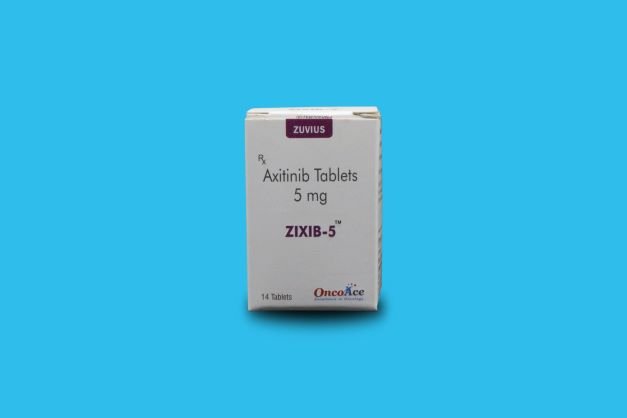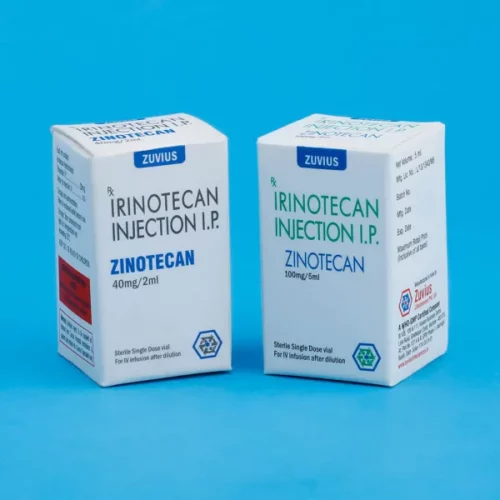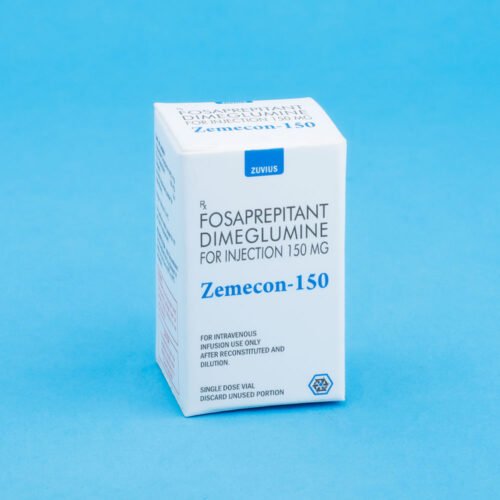Zixib Tab
Axitinib Tab
Strength: 1mg / 5mg
Pack Size: 1 x 14
Drug Class: Antineoplastics, Tyrosine Kinase inhibitor
Dosage and Administration:
Recommended Dosing
First-Line Advanced RCC
The recommended dose of AXITINIB is 5 mg orally taken twice daily (12 hours apart) with or without food in combination with avelumab 800 mg administered as an intravenous infusion over 60 minutes every 2 weeks until disease progression or unacceptable toxicity. When AXITINIB is used in combination with avelumab, dose escalation of AXITINIB above the initial 5 mg dose may be considered at intervals of two weeks or longer.
The recommended dose of AXITINIB is 5 mg orally twice daily (12 hours apart) with or without food in combination with pembrolizumab 200 mg every 3 weeks or 400 mg every 6 weeks administered as an intravenous infusion over 30 minutes until disease progression or unacceptable toxicity. When AXITINIB is used in combination with pembrolizumab, dose escalation of AXITINIB above the initial 5 mg dose may be considered at intervals of six weeks or longer.
Second-Line Advanced RCC
When AXITINIB is used as a single agent, the recommended starting oral dose is 5 mg twice daily. Administer AXITINIB doses approximately 12 hours apart with or without food.
Important Administration Instructions
Advise patients to swallow AXITINIB whole with a full glass of water. If the patient vomits or misses a dose, an additional dose should not be taken. Advise the patient to take the next prescribed dose at the usual time.
Cold Storage: no
Axitinib is a kinase inhibitor. Axitinib has the chemical name N-methyl-2-[3-((E)2-pyridin-2-yl-vinyl)-1H-indazol-6-ylsulfanyl]-benzamide. The molecular formula is C22H18N4OS and the molecular weight is 386.47 Daltons. The chemical structure is :
 |
Axitinib is a white to light-yellow powder with a pKa of 4.8. The solubility of axitinib in aqueous media over the range pH 1.1 to pH 7.8 is in excess of 0.2 μg/mL. The partition coefficient (n-octanol/water) is 3.5.
Inlyta is supplied as red, film-coated tablets containing either 1 mg or 5 mg of axitinib together with microcrystalline cellulose, lactose monohydrate, croscarmellose sodium, magnesium stearate, and Opadry® II red 32K15441 as inactive ingredients. The Opadry II red 32K15441 film coating contains lactose monohydrate, HPMC 2910/Hypromellose 15cP, titanium dioxide, triacetin (glycerol triacetate), and red iron oxide.
First-Line Advanced Renal Cell Carcinoma
Axitinib in combination with avelumab is indicated for the first-line treatment of patients with advanced renal cell carcinoma (RCC).
Axitinib in combination with pembrolizumab is indicated for the first-line treatment of patients with advanced renal cell carcinoma.
Second-Line Advanced Renal Cell Carcinoma
Axitinib as a single agent is indicated for the treatment of advanced renal cell carcinoma (RCC) after failure of one prior systemic therapy.
Clinical efficacy and safety
The safety and efficacy of axitinib were evaluated in a randomised, open-label, multicentre Phase 3 study. Patients (N = 723) with advanced RCC whose disease had progressed on or after treatment with one prior systemic therapy, including sunitinib-, bevacizumab-, temsirolimus-, or cytokine-containing regimens were randomised (1:1) to receive axitinib (N = 361) or sorafenib (N = 362). The primary endpoint, progression-free survival (PFS), was assessed using a blinded independent central review. Secondary endpoints included objective response rate (ORR) and overall survival (OS).
Of the patients enrolled in this study, 389 patients (53.8%) had received one prior sunitinib-based therapy, 251 patients (34.7%) had received one prior cytokine-based therapy (interleukin-2 or interferon-alpha), 59 patients (8.2%) had received one prior bevacizumab-based therapy, and 24 patients (3.3%) had received one prior temsirolimus-based therapy. The baseline demographic and disease characteristics were similar between the axitinib and sorafenib groups with regard to age, gender, race, Eastern Cooperative Oncology Group (ECOG) performance status, geographic region, and prior treatment.
In the overall patient population and the two main subgroups (prior sunitinib treatment and prior cytokine treatment), there was a statistically significant advantage for axitinib over sorafenib for the primary endpoint of PFS (see Table 2 and Figures 1, 2 and 3). The magnitude of median PFS effect was different in the subgroups by prior therapy. Two of the subgroups were too small to give reliable results (prior temsirolimus treatment or prior bevacizumab treatment). There were no statistically significant differences between the arms in OS in the overall population or in the subgroups by prior therapy.
Repeat dose toxicity
Major toxicity findings in mice and dogs following repeated dosing for up to 9 months were the gastrointestinal, haematopoietic, reproductive, skeletal and dental systems, with No Observed Adverse Effect Levels (NOAEL) approximately equivalent to or below expected human exposure at the recommended clinical starting dose (based on AUC levels).
Carcinogenicity
Carcinogenicity studies have not been performed with axitinib.
Genotoxicity
Axitinib was not mutagenic or clastogenic in conventional genotoxicity assays in vitro. A significant increase in polyploidy was observed in vitro at concentrations > 0.22 µg/mL, and an elevation in micronucleated polychromatic erythrocytes was observed in vivo with No Observed Effect Level (NOEL) 69-fold the expected human exposure. Genotoxicity findings are not considered clinically relevant at exposure levels observed in humans.
Reproduction toxicity
Axitinib-related findings in the testes and epididymis included decreased organ weight, atrophy or degeneration, decreased numbers of germinal cells, hypospermia or abnormal sperm forms, and reduced sperm density and count. These findings were observed in mice at exposure levels approximately 12-fold the expected human exposure, and in dogs at exposure levels below the expected human exposure. There was no effect on mating or fertility in male mice at exposure levels approximately 57-fold the expected human exposure. Findings in females included signs of delayed sexual maturity, reduced or absent corpora lutea, decreased uterine weights and uterine atrophy at exposures approximately equivalent to the expected human exposure. Reduced fertility and embryonic viability were observed in female mice at all doses tested, with exposure levels at the lowest dose approximately 10-fold the expected human exposure.
Pregnant mice exposed to axitinib showed an increased occurrence of cleft palate malformations and skeletal variations, including delayed ossification, at exposure levels below the expected human exposure. Perinatal and postnatal developmental toxicity studies have not been conducted.
Toxicity findings in immature animals
Reversible physeal dysplasia was observed in mice and dogs given axitinib for at least 1 month at exposure levels approximately six-fold higher than the expected human exposure. Partially reversible dental caries were observed in mice treated for more than 1 month at exposure levels similar to the expected human exposure. Other toxicities of potential concern to paediatric patients have not been evaluated in juvenile animals
Hypertension And Hypertensive Crisis
In a controlled clinical study with Axitinib for the treatment of patients with RCC, hypertension was reported in 145/359 patients (40%) receiving Axitinib and 103/355 patients (29%) receiving sorafenib. Grade 3/4 hypertension was observed in 56/359 patients (16%) receiving Axitinib and 39/355 patients (11%) receiving sorafenib. Hypertensive crisis was reported in 2/359 patients (<1%) receiving Axitinib and none of the patients receiving sorafenib. The median onset time for hypertension (systolic blood pressure >150 mmHg or diastolic blood pressure >100 mmHg) was within the first month of the start of Axitinib treatment and blood pressure increases have been observed as early as 4 days after starting Axitinib. Hypertension was managed with standard anti-hypertensive therapy. Discontinuation of Axitinib treatment due to hypertension occurred in 1/359 patients (<1%) receiving Axitinib and none of the patients receiving sorafenib
Blood pressure should be well-controlled prior to initiating Axitinib. Patients should be monitored for hypertension and treated as needed with standard anti-hypertensive therapy. In the case of persistent hypertension despite use of anti-hypertensive medications, reduce the Axitinib dose. Discontinue Axitinib if hypertension is severe and persistent despite anti-hypertensive therapy and dose reduction of Axitinib, and discontinuation should be considered if there is evidence of hypertensive crisis. If Axitinib is interrupted, patients receiving anti-hypertensive medications should be monitored for hypotension
Arterial Thromboembolic Events
In clinical trials, arterial thromboembolic events have been reported, including deaths. In a controlled clinical study with Axitinib for the treatment of patients with RCC, Grade 3/4 arterial thromboembolic events were reported in 4/359 patients (1%) receiving Axitinib and 4/355 patients (1%) receiving sorafenib. Fatal cerebrovascular accident was reported in 1/359 patients (<1%) receiving Axitinib and none of the patients receiving sorafenib.
In clinical trials with Axitinib, arterial thromboembolic events (including transient ischemic attack, cerebrovascular accident, myocardial infarction, and retinal artery occlusion) were reported in 17/715 patients (2%), with two deaths secondary to cerebrovascular accident.
Use Axitinib with caution in patients who are at risk for, or who have a history of, these events. Axitinib has not been studied in patients who had an arterial thromboembolic event within the previous 12 months.
Venous Thromboembolic Events
In clinical trials, venous thromboembolic events have been reported, including deaths. In a controlled clinical study with Axitinib for the treatment of patients with RCC, venous thromboembolic events were reported in 11/359 patients (3%) receiving Axitinib and 2/355 patients (1%) receiving sorafenib. Grade 3/4 venous thromboembolic events were reported in 9/359 patients (3%) receiving Axitinib (including pulmonary embolism, deep vein thrombosis, retinal vein occlusion and retinal vein thrombosis) and 2/355 patients (1%) receiving sorafenib. Fatal pulmonary embolism was reported in 1/359 patients (<1%) receiving Axitinib and none of the patients receiving sorafenib. In clinical trials with Axitinib, venous thromboembolic events were reported in 22/715 patients (3%), with two deaths secondary to pulmonary embolism.
Use Axitinib with caution in patients who are at risk for, or who have a history of, these events. Axitinib has not been studied in patients who had a venous thromboembolic event within the previous 6 months.
Hemorrhage
In a controlled clinical study with Axitinib for the treatment of patients with RCC, hemorrhagic events were reported in 58/359 patients (16%) receiving Axitinib and 64/355 patients (18%) receiving sorafenib. Grade 3/4 hemorrhagic events were reported in 5/359 (1%) patients receiving Axitinib (including cerebral hemorrhage, hematuria, hemoptysis, lower gastrointestinal hemorrhage, and melena) and 11/355 (3%) patients receiving sorafenib. Fatal hemorrhage was reported in 1/359 patients (<1%) receiving Axitinib (gastric hemorrhage) and 3/355 patients (1%) receiving sorafenib.
Axitinib has not been studied in patients who have evidence of untreated brain metastasis or recent active gastrointestinal bleeding and should not be used in those patients. If any bleeding requires medical intervention, temporarily interrupt the Axitinib dose.
Cardiac Failure
In a controlled clinical study with Axitinib for the treatment of patients with RCC, cardiac failure was reported in 6/359 patients (2%) receiving Axitinib and 3/355 patients (1%) receiving sorafenib. Grade 3/4 cardiac failure was observed in 2/359 patients (1%) receiving Axitinib and 1/355 patients (<1%) receiving sorafenib. Fatal cardiac failure was reported in 2/359 patients (1%) receiving Axitinib and 1/355 patients (<1%) receiving sorafenib. Monitor for signs or symptoms of cardiac failure throughout treatment with Axitinib. Management of cardiac failure may require permanent discontinuation of Axitinib.
Gastrointestinal Perforation And Fistula Formation
In a controlled clinical study with Axitinib for the treatment of patients with RCC, gastrointestinal perforation was reported in 1/359 patients (<1%) receiving Axitinib and none of the patients receiving sorafenib. In clinical trials with Axitinib, gastrointestinal perforation was reported in 5/715 patients (1%), including one death. In addition to cases of gastrointestinal perforation, fistulas were reported in 4/715 patients (1%).
Monitor for symptoms of gastrointestinal perforation or fistula periodically throughout treatment with Axitinib.
Thyroid Dysfunction
In a controlled clinical study with Axitinib for the treatment of patients with RCC, hypothyroidism was reported in 69/359 patients (19%) receiving Axitinib and 29/355 patients (8%) receiving sorafenib. Hyperthyroidism was reported in 4/359 patients (1%) receiving Axitinib and 4/355 patients (1%) receiving sorafenib. In patients who had thyroid stimulating hormone (TSH) <5 μU/mL before treatment, elevations of TSH to ≥10 μU/mL occurred in 79/245 patients (32%) receiving Axitinib and 25/232 patients (11%) receiving sorafenib.
Monitor thyroid function before initiation of, and periodically throughout, treatment with Axitinib. Treat hypothyroidism and hyperthyroidism according to standard medical practice to maintain euthyroid state.
Risk Of Impaired Wound Healing
Impaired wound healing can occur in patients who receive drugs that inhibit the vascular endothelial growth factor (VEGF) signaling pathway. Therefore, Axitinib has the potential to adversely affect wound healing.
Withhold Axitinib for at least 2 days prior to elective surgery. Do not administer for at least 2 weeks following major surgery and until adequate wound healing. The safety of resumption of Axitinib after resolution of wound healing complications has not been established.
Reversible Posterior Leukoencephalopathy Syndrome
In a controlled clinical study with Axitinib for the treatment of patients with RCC, reversible posterior leukoencephalopathy syndrome (RPLS) was reported in 1/359 patients (<1%) receiving Axitinib and none of the patients receiving sorafenib. There were two additional reports of RPLS in other clinical trials with Axitinib.
RPLS is a neurological disorder which can present with headache, seizure, lethargy, confusion, blindness and other visual and neurologic disturbances. Mild to severe hypertension may be present. Magnetic resonance imaging is necessary to confirm the diagnosis of RPLS. Discontinue Axitinib in patients developing RPLS. The safety of reinitiating Axitinib therapy in patients previously experiencing RPLS is not known.
Proteinuria
In a controlled clinical study with Axitinib for the treatment of patients with RCC, proteinuria was reported in 39/359 patients (11%) receiving Axitinib and 26/355 patients (7%) receiving sorafenib. Grade 3 proteinuria was reported in 11/359 patients (3%) receiving Axitinib and 6/355 patients (2%) receiving sorafenib.
Monitoring for proteinuria before initiation of, and periodically throughout, treatment with Axitinib is recommended. For patients who develop moderate to severe proteinuria, reduce the dose or temporarily interrupt Axitinib treatment.










